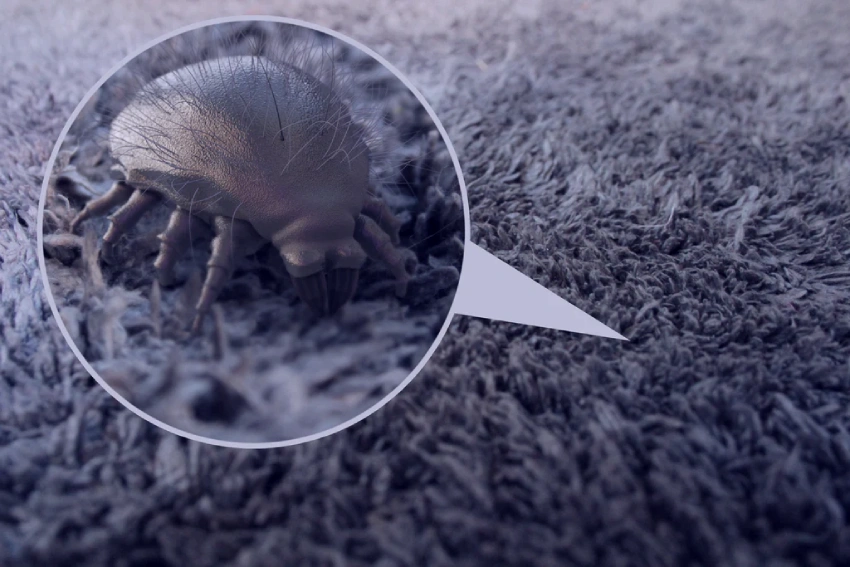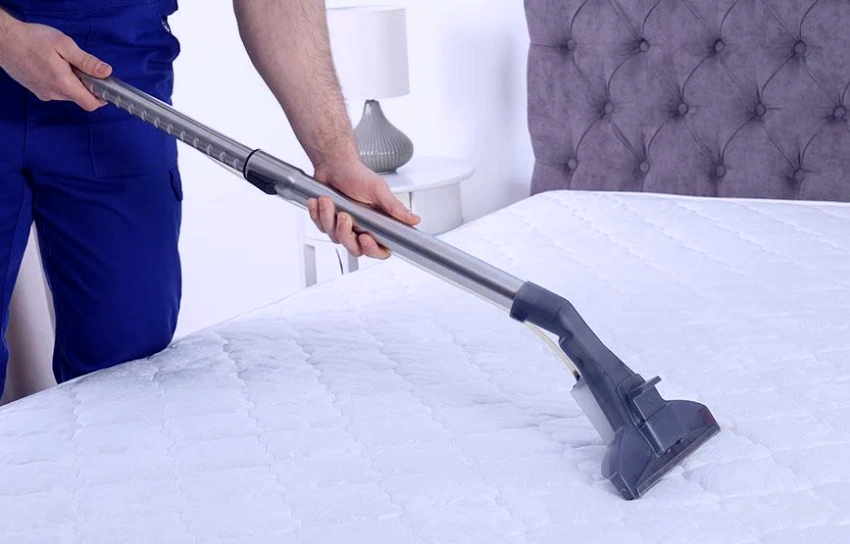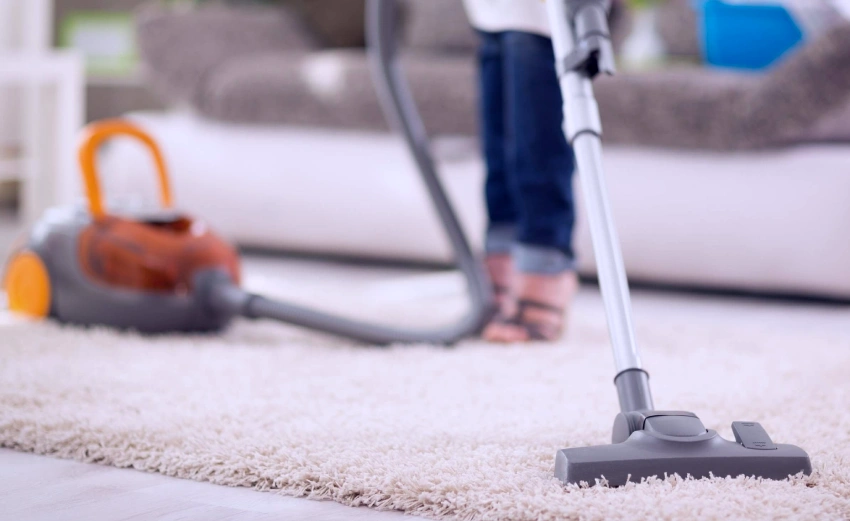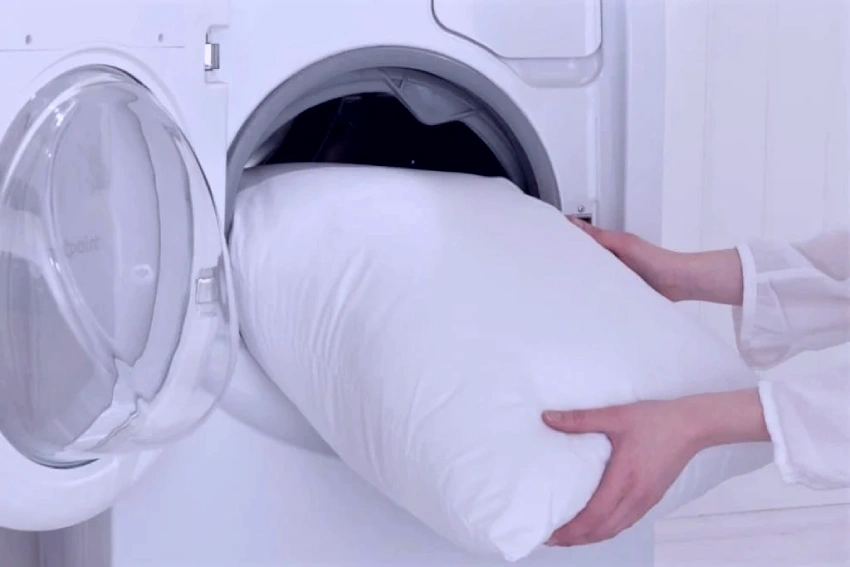Are dust mites causing you discomfort in your home? Don’t worry, we’ve got you covered! In this article, we’ll share some easy and effective ways to get rid of dust mites for good. From natural remedies to tackling the issue head on, we’ll provide the tips and tricks you need to make your home a dust-mite-free zone. Say goodbye to itching, sneezing, and wheezing—let’s dive right in!
How To Get Rid of Dust Mites Step-by-Step

How to Get Rid of Dust Mites Naturally
Fortunately, there are plenty of ways you can get rid of dust mites naturally without having to hire professional cleaning services. Regularly cleaning your home and your bedding, vacuuming, along with other methods will keep dust mites at bay. Removing dust mites is an on-going process, but by taking these steps consistently, you’ll achieve a spotless home free from these pesky insects.
1. Regularly Wash Bedding and Linens
Regularly washing bedding and linens is crucial for reducing dust mite populations in your home. Cleaning your bedding, blankets, and covers frequently helps eliminate allergens and prevents dust mites from thriving. By maintaining a weekly cleaning routine, you can create a healthier sleeping environment free from these unpleasant critters.
2. Vacuum and Dust Regularly
Vacuum and dust your home as often as you can to effectively reduce dust mites and allergens. Focus on areas where dust tends to accumulate, such as carpets, upholstery, and bedding. Opt for allergen-proof covers for mattresses and pillows to prevent dust mites from settling in these areas. Vacuuming surfaces consistently will prevent dust mite hot-spots like bedding and contribute to dust mite control.
3. Reduce Humidity and Moisture
Dust mites thrive in moist and humid environments. To combat dust mites, use a dehumidifier to control humidity levels, open windows frequently for a fresh breeze, and check that your vents are working properly.
4. Use Allergen-Proof Covers
To maintain your bedding dust mite-free, invest in allergen-proof covers for your pillows and mattresses. These covers create a protective barrier that prevents dust mites and other allergens from penetrating into your bedding, reducing the risk of dust mite allergies. Cleaning these covers weekly will help maintain their effectiveness in keeping allergens at bay.
5. Freeze or Heat Treat Infested Items
Freezing or heat treating infested items can help to get rid of dust mites and their allergens. Consider the following methods to minimize dust mites in your home:
- Place infested bedding, blankets, and covers in the freezer for at least 24 hours to kill dust mites.
- Heat treat infested items by washing them in hot water (at least 130°F) or placing them in a dryer on high heat for at least 20 minutes.
By using these freezing or heat treating techniques, you can reduce the presence of dust mites and alleviate allergy symptoms caused by these microscopic pests.
6. Clean Carpets and Upholstery
To successfully clean carpets and upholstery and reduce dust mites, follow these steps:
- Vacuum the carpets and upholstery thoroughly to remove loose dirt and debris.
- Use a carpet cleaner or steam cleaner to deep clean the carpets and upholstery.
- Treat stains with an appropriate stain remover product.
- Allow the carpets and upholstery to dry completely before using them again.

How to Get Rid of Dust Mites in a Mattress
Dust mites love warm and cozy spaces which also happen to be the spaces we frequent the most, including our bedrooms. Steps like protecting your mattress and regularly washing your bedding can prevent dust mites and help you regain a clean, comfortable bed.
1. Encase the Mattress and Pillows
Encase your mattress and pillows in dust mite-proof covers to trap and prevent further infestation. These covers create a barrier that protects your bedding from dust mites minimizing them and preventing allergens from spreading.
2. Wash Bedding Frequently
To prevent dust mites from thriving in your bedding, it’s important to wash them frequently. Here are some tips for washing bedding effectively:
- Wash sheets, pillowcases, and blankets once a week in hot water—aim for a temperature of at least 130°F (54°C).
- Use a gentle detergent that is free of perfumes and dyes.
- Dry the bedding on high heat to kill any remaining dust mites.
- Consider using allergy-proof covers for your pillows and mattress.
By following these steps, you can reduce the population of dust mites in your bedding and create a healthier sleeping environment.
3. Vacuum and Steam Clean the Mattress
Vacuuming and steam cleaning your mattress is an easy but powerful way to eliminate dust mites. Use a vacuum cleaner with a HEPA filter to thoroughly clean the surface of the mattress, focusing on seams and crevices. After vacuuming, use a handheld steamer to kill any remaining dust mites by applying hot steam directly onto the mattress.
4. Use Sunlight and Fresh Air
Let the fresh air and sunlight in by opening your windows on dry days. Dust mites prefer a warm and humid environment, so allowing fresh air to circulate can work to reduce their populations. Sunlight also has a natural disinfecting effect and can kill dust mites on surfaces exposed to direct sunlight.
Maximize the benefits of sunlight and fresh air by hanging your bedding outside to dry. The combination of UV rays from the sun and airflow will eliminate dust mites that may be hiding in your sheets, blankets, and pillows.
5. Consider Professional Mattress Cleaning
While a consistent cleaning routine can kill off dust mites, sometimes it’s best to leave the job to the professionals. Professional mattress cleaning services use specialized equipment and techniques to thoroughly remove dust mites and their allergens from your mattress, ensuring a healthier sleep environment for you and your family. With their expertise, they can successfully remove deep-seated dirt, stains, and odors that may be hiding within your mattress, giving you peace of mind knowing that your bed is clean and free from harmful allergens.

How to Get Rid of Dust Mites in the House
Having dust mites in your home is as unpleasant as it sounds. Although they’re invisible to the naked eye and don’t bite like bed bugs, dust mites can cause allergies, aggravate asthma, and even cause skin sensitivities and acne. By maintaining a consistent routine of vacuuming, cleaning, washing bedding, and more, you’ll be able to get rid of dust mites in your home and stay allergy-free.
1. Reduce Dust and Clutter
Clear out any unnecessary items from your living space and keep surfaces clean to minimize dust accumulation. Regularly decluttering and organizing your home will make it easier to control dust mite populations.
Vacuum carpets, rugs, and upholstery weekly using a vacuum cleaner with a HEPA filter to trap dust particles. Dust all surfaces with microfiber cloths or electrostatic dusters to prevent the spread of allergens.
2. Use Air Purifiers
One effective way to reduce dust mite populations in your home is by using air purifiers. These devices work by filtering the air and trapping particles such as dust mites, pollen, and pet dander. Place an air purifier in commonly used areas of your home, such as the living room or bedroom to help improve indoor air quality and minimize allergens that can trigger allergic reactions.
3. Wash Soft Furnishings Regularly
To further control dust mites, it’s important to regularly wash soft furnishings like curtains, bedding, and cushions. Follow these tips to effectively clean and eliminate dust mites from your upholstery, curtains, and carpets:
- Vacuum soft furnishings at least once a week using a HEPA filter.
- Wash pillow covers, bed sheets, blankets, and curtains in hot water (at least 130°F) every two weeks.
- Use allergen-proof covers on mattresses, pillows, and cushions to prevent dust mites from penetrating the fabric.
- Consider steam cleaning carpets and upholstery periodically to kill dust mites and remove allergens.
4. Maintain a Regular Cleaning Schedule
Maintaining a consistent cleaning routine is crucial in reducing dust mite populations. Vacuum carpets and upholstery at least once a week using a vacuum cleaner with a HEPA filter. Dust surfaces with a damp cloth to prevent the spread of dust particles into the air.
5. Keep Humidity levels low
To keep humidity levels low and prevent dust mites, use a dehumidifier in your home. Additionally, ensure your home has proper ventilation by checking your vents and opening windows whenever possible.

How to Get Rid of Dust Mites on Skin
While dust mites don’t bite, they can cause rashes, itchiness, and other unpleasant reactions. Fortunately, there are preventative measures you can take to greatly reduce the chances of dust mites irritating your skin.
1. Take Regular Showers
By showering regularly, you can remove any dust mites that may be on your skin and hair, preventing them from spreading to other areas of your home. Additionally, taking a shower before bed will help wash away allergens and create a clean sleeping environment.
2. Use Dust Mite-Proof Bedding
Using dust mite-proof bedding helps create a barrier between you and the mites, preventing them from coming into contact with your skin. Follow these steps to keep your bed clean and dust mite-free:
- Use dust mite-proof bedding to prevent dust mites from settling on your bed.
- Make sure to wash your bedding regularly in hot water to kill any existing dust mites.
- Encase your mattress, pillows, and box spring in allergen-proof covers.
- Avoid using down-filled comforters or pillows as they can attract dust mites.
3. Avoid Contact with Dust Mite Allergens
It’s important to avoid direct contact with dust mite allergens in order to eliminate them from your skin. To minimize contact with dust mite allergens, follow these tips:
- Wash bedding and stuffed animals regularly in hot water to kill dust mites.
- Use a vacuum cleaner with a HEPA filter to remove dust from carpets, upholstery, and mattresses.
- Encase pillows and mattresses in dust mite-proof covers.
- Avoid using curtains or rugs that can trap dust mites.
4. Use Hypoallergenic Skincare Products
Investing in hypoallergenic skincare products, especially if you’re prone to allergies will keep unwanted reactions from dust mites at bay.. From cleansers to moisturizers, these products are free from common irritants that can trigger allergic reactions and are specially formulated to work gently on the skin making them ideal for individuals with dust mite allergies. By opting for hypoallergenic options, you can enjoy clean and nourished skin without worrying about exacerbating your allergy symptoms.
5. Seek Medical Advice if Needed
If you suspect you have a dust mite allergy, it’s important to seek medical advice. A healthcare professional can accurately diagnose your allergy and provide appropriate treatment options. Don’t hesitate to consult with a doctor if you’re experiencing persistent symptoms or need guidance on managing your allergies effectively.
Dust Mites FAQ’s
How to know if you have dust mites?
Dust mites are microscopic creatures, so they are not visible to the naked eye. However, their presence can be inferred based on several factors:
- Allergy Symptoms: Dust mites are known allergens. If you or someone in your household is experiencing allergy symptoms such as sneezing, runny or stuffy nose, itchy or watery eyes, itchy skin, or asthma symptoms (like coughing, wheezing, tightness in the chest), it could be due to dust mites.
- Environment: Dust mites thrive in warm, humid environments. If your home is frequently humid or if you don’t use protective covers on mattresses and pillows, there’s a good chance you have dust mites.
- Dust Mite Test Kits: There are test kits available in the market that allow you to take samples from your home and send them to a lab for analysis. This can give a definitive answer on the presence of dust mites.
What kills dust mites instantly?
There are several methods to effectively kill and reduce the number of dust mites:
- High Temperatures: Washing bedding, curtains, and other fabrics in hot water (at least 130°F or 54°C) will kill dust mites. You can also use a steam cleaner on mattresses, upholstery, and carpets.
- Freezing Temperatures: If you have items that cannot be washed, placing them in the freezer for 24 hours can kill dust mites. Ensure the items are properly sealed in a bag to prevent moisture damage.
- Dust Mite Sprays: There are various sprays available in the market that are specifically designed to kill dust mites. Always read and follow label instructions when using such products.
- Diatomaceous Earth: This is a natural product made of fossilized remains of tiny, aquatic organisms called diatoms. When sprinkled on areas where dust mites reside, it can help in reducing their numbers. However, make sure to use the food-grade version and be cautious when applying, as it can be an irritant if inhaled.
What causes dust mites?
Dust mites are naturally occurring and can be found in most homes. Factors that contribute to their proliferation include:
- Food Source: Dust mites feed on dead human skin flakes, which we shed regularly. The presence of these skin flakes, especially in bedding, upholstery, and carpeting, can attract and sustain dust mite populations.
- Humidity: Dust mites thrive in environments with a relative humidity level above 50%. Homes that are regularly humid can foster larger populations of dust mites.
- Warm Temperatures: Dust mites prefer temperatures between 68°F (20°C) and 77°F (25°C), so homes kept in this temperature range are more conducive to dust mite growth.
- Soft Surfaces: Beds, upholstered furniture, and carpets provide ideal environments for dust mites because they trap the dead skin flakes and provide a safe habitat for the mites.
Reducing humidity, maintaining cleanliness, using protective covers, and frequent washing of fabrics can help in controlling and reducing the number of dust mites in a home.